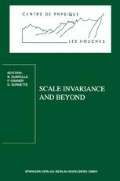Abstract
There has been considerable recent interest on large scale evolution biology. In the physics community this was triggered by the scenario of punctuated equilibrium, proposed by Gould and Eldredge [1], and by the work of Bak and co-workers stressing the similarities between this framework and the paradigm of Self Organized Criticality[2, 3]. Analyzing the fossil record[3, 4, 5], it has been realized that evolution might not take place smoothly, with small variations occurring at a more or less constant rate. Rather it occurred in bursts of very high activity, characterized by mass extinction, separated by periods of apparent stasis. More precisely, one can measure the number s t of species (or of families) which went extinct in an interval dt (typically of the order of one million years) around time t. The signal s t is intermittent, with quiet periods separated by large peaks on any size. The distribution P(s) of s t behaves as a power law P(s) ~ s −τ with τ ≈ 2. As discussed at length in ref. [3, 4, 5, 6], the main issue is whether the ecosystem as a whole has to be regarded as being in a “normal” state, characterized by linear response to external perturbations, or whether it is in a “critical” state, where external perturbations can trigger fluctuations of any size. In the former case, one has to assume that mass extinction have been provoked by extreme external events, such as meteor impacts, volcano eruptions and the like. This assumption suggests that the statistics of mass extinction events should be related to that of extreme catastrophic events. The second scenario, on the other hand, describes ecology as a system which is poised in a critical state by its dynamics itself. Even small perturbations can propagate and amplify in such a state, and produce in the end a macroscopic change.
Access this chapter
Tax calculation will be finalised at checkout
Purchases are for personal use only
Preview
Unable to display preview. Download preview PDF.
References
S. J. Gould and N. Eldredge, Paleobiology 3 (1977) 114.
P. Bak, C. Tang and K. Wiesenfeld, Phys. Rev. A 38 (1988) 364.
K. Sneppen, P. Bak, H. Flyvbjerg, and M. H. Jensen, Proc. Nat. Acad. Sci. 92 (1995) 5209.
R. V. Solé, and J. Bascompte, Proc. Roy. Soc. B 263 (1996) 161
] R. V. Solé, S. C. Manrubia, M. Benton and P. Bak, Self-similarity in the fossil record,Nature (to appear).
M. E. J. Newman, Proc. Roy. Soc. London B 263 (1996) 1605.
P. Bak and M. Paczuski, to appear in “Physics of Biological Systems” Lecture Notes in Physics ( Springer-Verlag, Heidelberg, 1996 ).
P. Bak and K. Sneppen, Phys. Rev. Lett. 59 (1993) 381.
M. Paczuski, P. Bak and S. Maslov, Phys. Rev. E 53 (1996) 414.
M. Marsili, G. Caldarelli and M. Vendruscolo, Phys. Rev. E 53 (1995) 13
M. Vendruscolo, P. De Los Rios, and L. Bonesi, Phys. Rev. E 54 (1996) 6053
D. A. Head and G. J. Rodgers, preprint adap-org/9611003 (1996).
N. S. Goel, S. C. Maitra and E. W. Montroll, Rev. Mod. Phys. 42 (1971) 231
G. Abramson, Phys. Rev. E 55 (1997) 785.
A. J. Lotka, J. Phys. Chem. 14 (1910) 271.Proc. Nat. Acad. Sci. 6 (1920) 410.
V. Volterra, Leçon sur la Theorie Mathématique de la Lutte pour la Vie ( Gautiers-Villars, Paris, 1931 ).
R. Redheffer and Z. Zhiming, Nonlinear Anal.-Th. Meth. & Appl. 5 (1981) 1303
Y. Takeuchi and N. Adachi, Ecol. Modelling 32 (1986) 95.
R. V. Solé and S. C. Manrubia, Phys. Rev. E 54 (1996) R42.
R. V. Solé and S. C. Manrubia, Phys. Rev. E 55 (1997)
R. V. Solé, J. Bascompte and S. C. Manrubia, Roy. Soc. London B 263 (1996) 1407.
R. Graber, M. Marsili, K. Sneppen and Y.-C. Zhang, in preparation.
R. W. Cottle, J.-S. Pang and R. E. Stone, The Linear Complementarity Problem ( Academic Press, London, 1992 ) p. 1.
To be precise, s t is the number of indices i where an extinction has taken place. We do not count unsuccessful species which did not survive at least one time step.
S. Zapperi, K. B. Lauritsen and H. E. Stanley, Phys. Rev. Lett. 75 (1995) 4071.
S. Alexander and R. Orbach, Journ. de Phys. Lettres 43 (1982) L625.
K. Hattori, T. Hattori and H. Watanabe, Progr. of Theor. Phys. Suppl. 92 (1987) 108.
J. E. Cohen, Community food webs: data and theory, (New York, Springer-Verlag, 1990 ). G. Caldarelli and U. Bastolla, private communication.
Author information
Authors and Affiliations
Editor information
Editors and Affiliations
Rights and permissions
Copyright information
© 1997 Springer-Verlag Berlin Heidelberg
About this paper
Cite this paper
Marsili, M. (1997). Models for Evolution and Extinction. In: Dubrulle, B., Graner, F., Sornette, D. (eds) Scale Invariance and Beyond. Centre de Physique des Houches, vol 7. Springer, Berlin, Heidelberg. https://doi.org/10.1007/978-3-662-09799-1_13
Download citation
DOI: https://doi.org/10.1007/978-3-662-09799-1_13
Publisher Name: Springer, Berlin, Heidelberg
Print ISBN: 978-3-540-64000-4
Online ISBN: 978-3-662-09799-1
eBook Packages: Springer Book Archive

